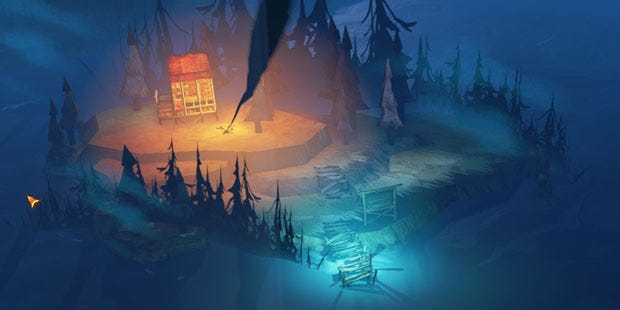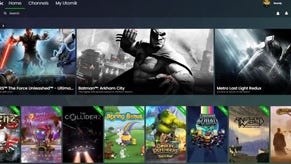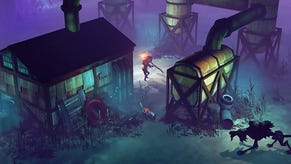The Great Outdoors: The Flame In The Flood
How tiny worlds were made
The Flame in the Flood's [official site] lead designer, Forrest Dowling seemed like an ideal candidate for my ongoing investigation of outdoor worlds in videogames both because of his name and because of his survival game. The Flame And The Flood sees you play as Scout, a woman trying to stay alive as she navigates her way along a fiercely flowing river. It manages to be a strangely cosy version of the outdoors with a wonderful, evocative colour palette and soundtrack. Here's how it works:
Pip: The Flame In The Flood has a strong sense of Americana, from the floodlands to the music. How do you break that idea down and start to get the sensation right?
Forrest Dowling: That's a good question. I think a lot of the feel came directly from our art director, Scott Sinclair, who originally is from Florida and grew up on a river in Florida. So this is very much just his homeland.
We looked at a lot of references of American Southern waterways and picked and chose the things we thought were the most iconic or things that felt quintessentially part of what you imagine the landscape to be. That played into the assets that Scott was creating as well as the locations you visit.
You visit different specific location types and, of course if you're illustrating the American South, the church is an absolute must-have. We tried to match up locations with function, so that list came about from looking at the locations we wanted to have and the functions they needed and trying to fit them together in a way that made sense.
A church is always a place where you can find shelter. Thematically it works but also it just works in terms of any small town, any crossroad down south is going to have a church. Or the filling station. The roadside gas station is another kind of iconic thing. The bait shack is another [place] you see on waterways down south.
It was a mix of finding the function we needed and matching it with the form that was appropriate for the illustration. A lot of it was just thinking about 'What do people associate with that particular part of the world?'
The way the assets work and the locations are generated, the game also felt cosy to me (you can never go too far from the river and each location has a limited number of assets/limited variety of layouts). Is that something you were aiming for or did you want wilderness? How expansive was the game intended to feel?
Forrest Dowling: One of the very first sparks that started this game and started the design was, again, from our art director. He was interested in exploring as he put it 'tiny worlds'. The idea was he wanted to make something where essentially you're driving an avatar around a little space and just exploring it. I think that a lot of the feel, especially of exploration, came from that idea.
Even the fact that when you're exploring the borders are all vertical - essentially you're blocked, not because you can't go down into the water but because you're encased in wilderness. Those are very intentional to make you feel like you're in this cosy little space.
Also that comes from the palette, both in terms of the palette used on the assets themselves and then the palette used for light and atmosphere. We had two artists who built the whole game. One was making all the assets and the other was setting up the way they would spawn together in the world. They worked really well together in terms of getting a nice base colour for everything that was very warm and colourful then augmenting that with a great job of lighting and atmosphere.
The river that you ride on ties the game together and provides a literal through-line for the game. What was it like trying to get that right and what were the biggest challenges?
Forrest Dowling: I think one of the biggest challenges with the river is that from the get-go we wanted it to be something that felt powerful. Part of its function is it is a thing that will be driving you forward, much like the enemy fleet in FTL is driving you forward. There's a reason you can't go back.
But the problem, fundamentally, there is the fact that a player needs to have control and agency but the river needs to also have control. So trying to hit the right balance where you can control and make decisions on the river and it was an engaging activity while still feeling like you're at its mercy, I think that was the biggest challenge.
There was a lot of tuning that went into how much you can boost [You can use a pole to push yourself in a particular direction – it's not enough to push you backwards but you can try to nudge yourself across to other docking locations]. I think we didn't even have boosting initially and that became important and how powerful it was and how much damage you got from an impact [when your raft hits the rocks] and how much your movement was influenced by the river and how much it was influenced by your input. I think we got to a pretty good spot with it overall but there was a lot of just very fiddly tuning to make it work.
And fine-tuning the raft upgrades too, I'm guessing...
Forrest Dowling: Yeah. All the upgrades needed to be clearly and objectively better than what you had before, especially the control ones like the motor and the rudder, but not so much better that they broke the experience. It was pretty finicky.
The other thing with the river, we played with a lot of variables like camera distance and camera positioning and river density and rapids speed. All these things got tuned down to 0.01% changes towards the end. One of the challenges with the river too was achieving a density with it where it felt like you had choices to make and places to go and there were mutually exclusive decisions to be made without packing it with so much stuff that it felt like an amusement park or something.
There were some earlier prototypes where the camera was a bit farther out and the density of locations was higher and it just felt too wacky. There was way too much stuff. Essentially we arrived at clusters of 4-6 visible locations over a certain distance and certain river width and a certain speed and whatnot.
Looking on the discussion forums, some people's endless mode games have been going for hundreds of days. At some point does that break the experience or the concept? Do you become too aware of the game-iness?
Forrest Dowling: I think if you're going to play endless mode and go for a super long run you need to be pretty okay with the gaminess of it and the folks that are doing those crazy long runs have developed some pretty good strategies for how to do it. One thing that happens over time too is resources thin out so it gets to be harder and harder so you can no longer really trap animals. One of the guys who did a year-long run I think essentially never used traps. He used snakes and kited animals into them so the snake would bite the animal and he could kill it and harvest it.
We did a Kickstarter about a year and a half ago and endless mode was actually a stretch goal. That wasn't even part of the original plan for the game. I'd always envisioned it as being a little shorter than what the end experience ended up being but a very finite experience and I felt like the amount of content was correct for something where you sit down for 4-5 hours.
For me endless was never the real core idea for it and it surprised me how much people are spending on it or investing in it. I guess it shouldn't be surprising. Jamie Cheng gave a talk maybe last year or the year before - maybe it wasn't him, it was about Don't Starve, regardless, and they were talking about the expectation when they released the game. Maybe people would make it 15 days, maybe 20 or 30 but that's about the cap. Then people were making it hundreds of days and going deeper into the game than they expected.
I think we had a very similar experience where endless mode is there if people wanted to see how far they could make it but I didn't think people would make it as far as they did and the way it's tuned I didn't really think anybody was going to make it past day 100 or 120, something like that. But people have more than doubled that or tripled it. It's surprising but I guess it shouldn't be because people are good at figuring out systems.
Was there anything you couldn't make work?
Forrest Dowling: Maybe there is one area we would have liked to have developed further but weren't really able to figure out because of the more important stuff – [and that] was far more procedural content when you're exploring, like stuff we had in the Kickstarter video like a lot of text in the world that never really came to pass.
Largely that came about because you have a finite amount of development time and an engineer who is going to do that or he's going to work on the AI and ultimately AI wins because that's the actual thing you're interacting with.
So we had some bigger ideas about how procedural certain aspects were going to be, like we talked about doing, I guess maybe this would be a big idea, like procedural mise en scène that really didn't come to pass. Essentially the way the procedural generation works is there's all these little components and collections of things that are then randomly selected when you go to a location based on what that location is.
Like families of objects?
Forrest Dowling: Yes. But within that family there's not a lot of a huge amount of sub-variation that can occur. When you visit a farm there's one of x number of farm layouts that it's going to choose from based on the biome that you're in but it's not going to alter those layouts a lot. There's a lot of reasons that's really challenging ranging from keeping things pathable to keeping things presentable. Obviously we're a little precious about what you actually see on screen and letting go is a bit hard.
Thank you for your time.
For more posts about The Great Outdoors just check out The Great Outdoors tag page





















